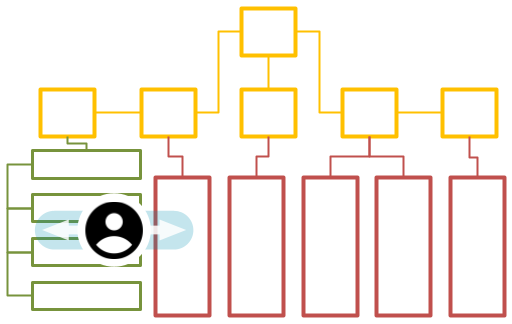A Change Stabiliser is a methodical and pragmatic individual dedicated to maintaining organisational order and predictability. They prioritise procedural fidelity, ensuring consistent operations through adherence to established routines and standards. Analytical and proactive, they navigate change with caution, balancing innovation with stability. Their communication is clear and empathetic, fostering trust and harmony. Amidst change, their primary concerns are compliance, quality, and minimising disruptions.
A Change Stabiliser:
is procedural
Process Adherence: Prioritise established routines, procedures, and norms for smooth operations.
Detail Conscious: Possess a meticulous nature, acting as quality gatekeepers within the organisation.
Rule Abiding: Display a strict adherence to rules, standards, and regulations.
Dependable: Consistently deliver on commitments, fostering trust by maintaining the status quo.
Well Organised: Use superior organisational skills to manage various procedures and processes.
is systematic
Methodical Mindset: Utilise logical and structured approaches for thinking and working.
Analytical Outlook: Rely heavily on data and facts for decision-making.
Strategic Thinker: Plan ahead and align actions with the organisation’s long-term goals.
Proactive Planner: Anticipate potential issues and make efforts to prevent them before they arise.
advocates stability
Risk Conscious: Show a preference for stability and cautiousness over unnecessary risks.
Consistency Keeper: Maintain steady, predictable performance and encourage the same in others.
Pragmatic: Make decisions and actions based on practical realities.
Resilience Exhibitor: Effectively manage stress and maintain performance under pressure.
Steady Performer: Unwavering in the face of fluctuations, ensuring stable output regardless of circumstances.
is a patient problem solver
Patience Practitioner: Understand the importance of measured progress and are comfortable with gradual processes.
Efficient Problem-Solver: Tackle obstacles adeptly and find effective solutions to challenges.
Persistent Pursuer: Show commitment and resilience in the face of challenges.
Diplomatic: Manage conflicting interests and difficult situations with grace.
Reflective Learner: Learn from past experiences and incorporate those lessons into future problem-solving.
is a composed decision maker
Calming Influence: Bring a sense of calm and order, especially in chaotic situations.
Decisive Executor: Make clear, definitive decisions, cutting through ambiguity to provide direction.
Objective Thinker: Base decisions on facts, refraining from emotional bias.
Confident: Exhibit confidence in decisions, providing reassurance to others in times of uncertainty.
is an effective communicator
Active Listener: Pay full attention to others’ ideas, fostering a sense that everyone’s voice matters.
Clear Articulator: Express thoughts and ideas in a clear, concise manner.
Empathetic Connector: Understand and share others’ feelings, building trust within the team.
Role in the conventional organisation:

Perspectives on, and challenges arising from Change
Questions they may ask themselves in Change situations
Are the current systems and processes being adhered to properly?
How can I minimise the potential disruptions caused by changes?
What potential risks or obstacles might we encounter in this process?
How can I ensure consistent performance amidst the changes?
Am I effectively communicating the importance of stability to my team?
How can I better communicate the importance of compliance to my team?
Is there a potential for improved efficiency in current processes?
How do I balance the organisation’s needs for both stability and change?
How can I anticipate potential disruptions and prepare for them?
What can I learn from past experiences to apply in maintaining stability during future changes?
Reasonable Expectations in Change situations
Team members understanding and respecting the importance of processes and routines.
Smooth integration of necessary changes with minimal disruption to the status quo.
Consistent performance and quality from all areas of the organisation.
Effective and open communication within the team about any changes or potential disruptions.
Teams adapting to changes while maintaining respect for existing processes and standards.
Leadership that supports their role and understands the importance of balance during times of change.
All employees, regardless of level, adhering to established routines and procedures.
Early and transparent notification of upcoming changes so they can plan for stability.
Roadblocks to progress in Change situations
Resistance to process adherence from team members who prefer flexibility.
Limited resources (time, manpower, etc.) to monitor and maintain stability in all processes.
Difficulties in making people understand the importance of maintaining stability during changes.
Dealing with unexpected problems or emergencies that disrupt established routines.
Lack of a clear and concise communication strategy to convey changes to everyone.
Bureaucracy or red tape that slows down the implementation of necessary changes.
Trying to maintain stability in an organisational culture that heavily favours risk and innovation.
Difficulties in measuring the impact of their role, as the lack of problems (their main goal) is harder to quantify than problem-solving.
Types of Problem that may be encountered in Change situations
Misalignment or non-compliance with established processes or standards.
Difficulty in managing resistance to change from employees who are comfortable with the status quo.
Struggling to balance the need for maintaining stability with the need for necessary changes.
Overwhelm due to multitasking, as they are often involved in various processes across the organisation.
Managing the anxiety and uncertainty that comes with change within the organisation.
Balancing innovation with maintaining essential structures and processes.
Resolving conflicts between different teams or departments due to change-induced stress.
Ensuring sufficient resources to maintain the stability of various functions.
Motivating Desires in Change situations
Desire for order, predictability, and control in organisational processes.
Desire to ensure quality and consistency in the face of changes.
Desire to maintain compliance with all necessary regulations and standards.
Desire for an organised and well-structured work environment.
Desire to minimise risks and avoid potential problems before they occur.
Desire for respect.
